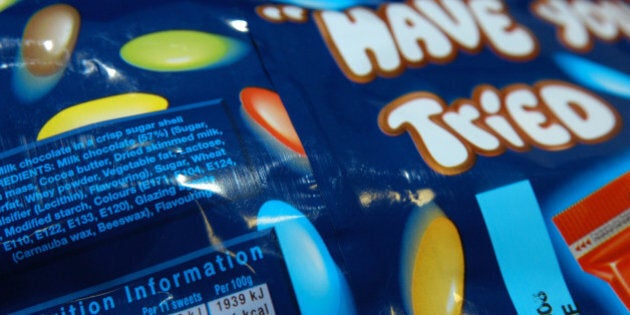
If you are like me, and we are both children of the '80s, then you'll know and recall the wonder that was blue food. Some of my earliest candy-related memories is after swimming at the local pool, getting candy from the vending machine, then separating Skittles, Smarties, and M&Ms by colour, and devouring them in order of colour preference. I don't think I'm unique in this respect. But I always remember that the last colour left was always greens or purples, being the closest thing there was to blue. Then the game changer happened.
The dye is produced by combing the aromatic hydrocarbons from petroleum and can be added to tartrazine to give variant shades of green. If you are one of these hip chemistry types born of the "Breaking Bad" world, then you can appreciate the fact that the chemical formation is C37H34N2NaO9S3... but even knowing all this, it doesn't change the fact our intestines are not able to properly absorb it properly, and thusly it is also used to make blue poop.
This was the food dye I'd be waiting for my whole young life, E133 to some, Brilliant Blue FCF to others, as it began finding its way onto store shelves. Prior to this, the only thing that you could find this shade of blue in was antifreeze. Now the door was open and this disodium salt was making an appearance in everything from mouth wash to icing, soups, liqueurs, and ice cream. And candy. Especially candy.
As far as I was concerned, when blue food was available it was game on, and I remember every time I was offered confections, no matter what I was in the mood for flavour-wise, I found my eye being drawn to any colour resembling cornflower blue. I'm not sure what taste I was expecting when I bit down, and what I really tasted was disappointment for it not being the perfect flavour.
But what was blue supposed to taste like? While doing research for this (and let me say my research has been going on for 27 years at this point) I started taking stock of what blue foods I consumed, and now I've had the wherewithal to look up the ingredients.
So, what does "blue" actually taste like? Despite often times being touted as "berry" or in the case of the '80s/'90s "X-Treme" marketing type advertisements "WILD berry," the flavour is often some raspberry mixed with apple. I've yet to live to see blue raspberries, or apples, and even if there was some elite farmer in Japan crafting overpriced GMO fruits for such a thing, it's not what I had in mind.
Oh, the '80s. Era of neon colours, video games, and MTV. The time when visual stimuli ruled supreme. I don't think this was an accident, either. After reading American Psycho as an adult, I got a better idea of the consumer greed of that era and when piecing together childhood memories overlaid with this opposite point of view of an overindulgent adult world, I think I've got a pretty good idea of what the fuck was going on in North America in the '80s -- mainly, not to put too fine a point on it, good old-fashioned fuckery.
Wars had been won, things were on the economic up and up, and people wanted to spend. To spend, they needed to work more, so lots of households had absent parents who later overcompensated to their offspring with video games, toys in McDonald's meals and, of course, blue food.
One of my favourite books about pop culture and food, Fast Food Nation, even touches on the uniqueness of the '80s in terms of marketing. Author Matt Deluna describes it as the decade of the "child consumer."
Deluna points out, "In the '80s companies began to market to the young so they could present themselves as good influences throughout the kid's lives. For example, advertise to a 5 year old so he thinks McDonalds is then it becomes a child hood past time. When people love something in their child hood, usually their opinion rarely changes."
So now we've got a generation of children who, whether their parents are single parents working all hours to support their families or double income parents who lavish material things on their offspring to make up for letting Saturday morning cartoons and Nintendo become their caretakers fall back onto one thing: Blue Food.
Blue Food was everything I wanted in that shiny, plastic, over processed world. Everything I had been taught by marketing experts to covet in the number of other girls' dolls, to whose mom bought them Booberry for breakfast. It was empty calories, high fructose promises, and false happiness. The crashes, both sugar and stock market, were inevitable.
It was impossible to maintain and who knows how much damage we've done to our brains, bodies and economy in the long run because of it. Don't think for a moment that I can resist sapphire icing on birthday cake, or sucking blue Smarties to give my tongue a temporary cobalt hue; I'm nothing if not sentimental and given over to nostalgia.
But I like where we are now: we are trying to give our children connections to our food beyond plastic packaging. Homemade and well-crafted seems to be gaining momentum over highly processed and mass produced. Love invested in products rather than on the backs of desperate workers overseas.
The process isn't perfect yet, but I've got high hopes. And I'm hoping soon that when it gets hotter and one of my friend's small children ask me what blue tastes like, I can offer them a blueberry that's been warmed slightly by the sun, washed free of soil that is spray free, and say, "Like this."
ALSO ON HUFFPOST:
